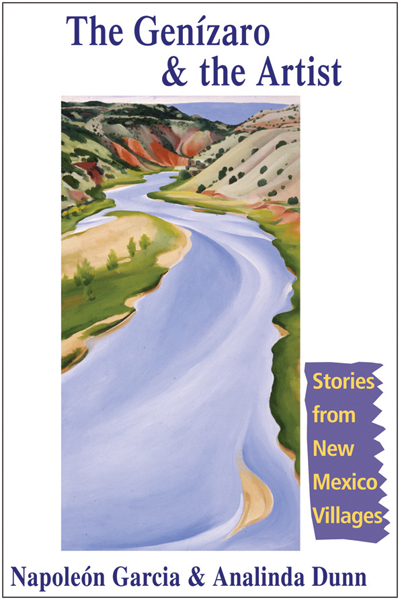Stories from New Mexico Villages
by Napoleón Garcia and Analinda Dunn
54 photographs - 124 pages
BOOK REVIEWS

Although Georgia O’Keeffe is one of New Mexico’s most frequently chronicled residents, rarely do we read about the iconic painter from the perspective offered in The Genizaro & The Artist. Written by Napoleon Garcia, an Abiqiui native and genizaro (a person who claims both Colonial Spanish and Native American heritage), this slender volume relates Garcia’s memories of his interactions with the artist—he did odd jobs for her, and worked as her chauffeur. He writes, “I want to tell the story of our village and how we accepted this world famous artist into our way of living. She became a ‘villager’ here. She respected our way of life and had no desire to change us as so many outsiders want to do.” This is a poignant book about a hardworking man, a simple northern New Mexico village, and the iconic artist who left her mark on them. -- New Mexico Magazine, April 2009
Part of the award-winning "Stories from New Mexico Villages" series, The Genizaro & the Artist: Stories from New Mexico Villages is the memoir of author Napoleon Garcia, a longtime Genizaro (individual who claims descent from both Colonial Spanish settlers and Native American tribes) resident of Abiquiu, New Mexico, who knew and worked for Georgia O'Keeffe during the forty years in which she called Abiquiu home. Though Garcia has been interviewed about O'Keeffe before, The Genizaro & the Artist tells in his own words, pace, and style (with help from his friend Analinda Dunn) what it was truly like to know a famous artist as a fellow villager. A handful of black-and-white photographs illustrate this testimony, especially recommended for anyone interested in a different, down-to-earth perspective on Georgia O'Keeffe. -- MidWest Book Reviews
All good biographies and histories, whether sweeping in scope or minutely focused, rely on the stories of individuals to bring them to life. The Genizaro & the Artist delights the reader with both small, brightly polished details and larger pieces of history most likely unknown to the average New Mexican.
This thoughtful, gentle book contains the story of Napoleon Garcia, a Genizaro born and raised in Abiquiú, NM. As he and his coauthor Analinda Dunn explain, the Genizaros (a term long fallen out of use) were native peoples made slaves by the early Spanish settlers, then baptized into Christianity with the goal of eradicating all indigenous identity. According to the authors, the Genizaros “came from many of the nomadic tribes, such as the Navajo, Utes, Comanches, Kiowa, Pawnee, Apache, and other non-Pueblo Indians” who were in the area at the time of Spanish colonization. In later generations, these families intermarried with Spanish families.
Abiquiú is one of the best known of the Genizaro communities involved in the Spanish land grants of the mid-1700s. It is also known as the home of artist Georgia O’Keefe for 40 years, at the start of which time Garcia was a neighbor boy who ran errands for her. His reminiscences of Abiquiú, of Genizaro history and customs, of Ghost Ranch and curanderas, and of his interactions with the “artist lady” and her life in the community should interest not only historians and fans of Georgia O’Keefe but also sociologists, anthropologists, folklorists, and curious readers in general.
The two voices in The Genizaro & the Artist are those of Garcia (speaking in the first person) and Dunn (speaking in the third). These friends create a sweet duet, reviving for us a world now gone and showing the strands that remain interwoven in the Abiquiú of today, where Garcia reigns as one of its elders and local characters. I recommend this slim volume for the gem-like stories, photos, insights, and generosity of spirit running through its deceptively straightforward narrative. -- www.readingnewmexico.com
$15.95/PB (978-1-890689-28-5)
$27.95/HB (978-1-890689-36-0)

Many journalists and authors have come to the village, interviewed some of the locals and then return to their big city desks and write about the quaint village life, its inhabitants and its famous world reknown artist. However, there has never been a book written from the perspective of a native from the village. Not only is Napoleón Garcia a native of Abiquiú, he knew and worked for Georgia O’Keeffe over the 40 years that she made Abiquiú her home, living “around the corner” from his home on the plaza in the pueblo.
ABOUT THE AUTHORS
After completing 30 years with the Federal Civil Service in Washington, D.C in computer technology, Analinda Dunn began a 15-year career in elementary education. She traveled the Lewis and Clark Trail during the recent Bicentennial Commemoration events of 2003-2006 in her 16 foot travel trailer, journaling and documenting her adventure. Napoleón Garcia is a Genízaro native of Abiquiú, New Mexico. Native folklore, area history, and personal tales of growing up and living in a remote village in northern New Mexico provide the substance of the stories that Napoleón likes to tell. He also knew and worked for the artist, Georgia O’Keeffe who lived the last 40 years of her life in his village, just “around the corner.”

